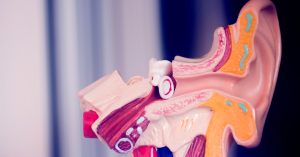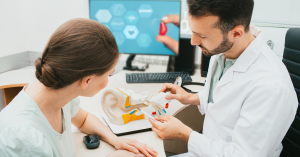Hearing health is a critical part of overall well-being, yet many people are unaware of the tools used to assess and protect it. One such tool is the Otoacoustic Emissions (OAE) test, a non-invasive, quick, and reliable way to evaluate the function of the inner ear. Often used in newborn hearing screenings and routine audiology checkups, this test provides valuable information about how well the cochlea is working.
Unlike traditional hearing tests that rely on patient responses, the OAE test measures sound waves produced by the inner ear itself — making it especially useful for infants, young children, or individuals who can’t respond reliably to standard hearing tests. With its growing application in both pediatric and adult audiology, the OAE test plays an essential role in early hearing loss detection and diagnosis.
In this article, we’ll explore what the OAE test is, how accurate it is, the various ways it’s used, and what you can expect if you or a loved one needs this test. Whether you’re navigating hearing concerns for yourself or caring for someone else, understanding the OAE test can help you make more informed decisions about hearing health.
What Is an OAE Test?
The Otoacoustic Emissions (OAE) test is a specialized hearing assessment that evaluates how well your inner ear, specifically the cochlea, is functioning. It works by detecting tiny sound waves — known as otoacoustic emissions — that are naturally produced by the outer hair cells in a healthy cochlea in response to auditory stimulation.
When a soft clicking or tone is played into the ear via a small probe, the outer hair cells in the cochlea should respond by producing faint echoes. These echoes are measured by a sensitive microphone within the same probe. If the cochlea is functioning properly, these emissions are present and measurable. If there is damage to the outer hair cells — which often occurs in hearing loss — the emissions will be weak or absent.
How the Test Works
An OAE test is performed using a small, soft probe that is gently inserted into the ear canal. The probe contains both a speaker to deliver the sounds and a microphone to pick up the ear’s response. The test is completely painless, requires no behavioral response from the patient, and usually takes just a few minutes per ear.
There are two main types of OAE tests:
- Transient Evoked Otoacoustic Emissions (TEOAE): Uses brief clicks or tone bursts to evoke a response. Commonly used in newborn screening.
- Distortion Product Otoacoustic Emissions (DPOAE): Uses two continuous tones of different frequencies to measure cochlear response. Often used in diagnostic evaluations for older children and adults.
Why It Matters
OAE testing is particularly valuable because it detects cochlear damage at a very early stage — even before it shows up on standard hearing tests. It’s commonly used for:
- Newborn hearing screening
- Pediatric hearing assessments
- Monitoring for ototoxicity (hearing damage caused by medications)
- Evaluating auditory neuropathy and sensorineural hearing loss
By providing insight into the health of the inner ear, the OAE test helps audiologists and hearing specialists determine whether further testing is needed and what kind of hearing support may be appropriate.
How Accurate Is the OAE Test?
The OAE test is widely regarded as a highly accurate and reliable tool for detecting cochlear (inner ear) function, especially in identifying issues with the outer hair cells. Its accuracy lies in its ability to detect even subtle cochlear abnormalities — often before they become apparent in traditional hearing tests.
Sensitivity and Specificity
In clinical settings, the OAE test boasts excellent sensitivity (ability to correctly identify those with hearing loss) and specificity (ability to correctly identify those without hearing loss). For newborn hearing screening, studies show that OAE testing can detect moderate to profound hearing loss with over 90% sensitivity, making it an essential first step in early hearing loss detection.
However, it’s important to note that the test focuses solely on cochlear function. If the hearing loss originates beyond the cochlea — such as in the auditory nerve or brainstem — the OAE test may return a normal result despite the presence of hearing difficulties. This is why OAE tests are often combined with other assessments, like the Auditory Brainstem Response (ABR) test, for a more comprehensive view.
Factors That Can Affect Accuracy
While the OAE test is highly effective, a few factors can interfere with its accuracy:
- Middle ear fluid or infections: These can block the emissions from traveling back out of the ear, leading to false results.
- Excessive earwax: Can obstruct the ear canal and affect the ability to capture emissions.
- Ambient noise or patient movement: Especially in infants or children, movement can affect the recording, though most audiologists are trained to work around these challenges.
For these reasons, a “refer” result (meaning the test was inconclusive or suggests potential hearing loss) doesn’t automatically confirm hearing impairment. It simply indicates that further evaluation is needed.
Ideal Use Scenarios
The OAE test shines in environments where behavioral testing isn’t feasible, such as:
- Testing newborns, infants, and toddlers
- Evaluating non-verbal individuals or patients with developmental delays
- Monitoring for drug-induced hearing loss
- Providing quick screenings in schools, clinics, or community settings
In these cases, the accuracy of the OAE test provides clinicians with a powerful diagnostic starting point.
Common Uses of the OAE Test
The OAE test is a versatile tool used across a wide range of clinical and screening environments. Its non-invasive nature, quick administration, and ability to detect cochlear damage make it invaluable in both pediatric and adult hearing care. Let’s explore the most common situations where the OAE test is used and why it’s so essential in each.
Newborn Hearing Screening
Perhaps the most well-known use of the OAE test is in universal newborn hearing screening. Before babies leave the hospital, many receive an OAE test to check their hearing. Because the test doesn’t require any response from the baby and takes only a few minutes, it’s ideal for identifying congenital hearing loss early — often before speech and language development begin.
When a baby “passes” the OAE test, it indicates healthy cochlear function. If they “refer” (i.e., fail), they are typically retested or referred for an Auditory Brainstem Response (ABR) test to confirm the findings. Early detection allows for timely intervention, which is crucial for a child’s communication and developmental milestones.
Pediatric Hearing Assessments
As children grow, the OAE test continues to be useful. In preschool and elementary-aged children — especially those who may have difficulty cooperating with traditional hearing tests — OAE testing provides a fast and objective way to monitor ear health. It’s often used:
- To screen for middle ear infections (otitis media), which are common in young children
- As part of evaluations for speech delays
- When children are not responding to sounds as expected
Adults and Ototoxic Monitoring
In adults, OAE tests are less commonly used for routine hearing evaluations but are extremely valuable in monitoring for ototoxicity — hearing damage caused by certain medications, such as chemotherapy drugs or antibiotics like gentamicin. Regular OAE testing can detect early cochlear damage, even before the patient notices symptoms or changes appear on audiograms.
Assessing Auditory Neuropathy
Another critical use of the OAE test is in evaluating auditory neuropathy spectrum disorder (ANSD), a condition where sound enters the inner ear normally, but the transmission of signals from the inner ear to the brain is impaired. People with ANSD may have normal OAEs but abnormal ABR results — making OAE testing a key component in diagnosing this unique form of hearing loss.
Screening in Schools and Community Settings
The OAE test is also popular for hearing screenings in schools, community clinics, or remote areas, where quick, objective results are needed. Since it doesn’t require a verbal response, it can be performed efficiently on many individuals in a short period of time.
OAE Test vs Other Hearing Tests
While the OAE test is a powerful tool for assessing cochlear health, it’s just one of several tests audiologists use to evaluate hearing. Each hearing test provides different types of information, and understanding how the OAE test compares to others can help clarify its unique role in diagnosis and treatment planning.
OAE Test vs. Pure-Tone Audiometry
Pure-tone audiometry is one of the most common hearing tests, especially for adults and older children. It requires the individual to respond to a series of tones at varying pitches and volumes by pressing a button or raising a hand.
- Key Difference: Audiometry measures a person’s behavioral response to sound, while the OAE test measures the physical response of the cochlea itself.
- Strengths of OAE: Ideal for non-verbal individuals, infants, and situations where accurate behavioral responses are difficult to obtain.
- Strengths of Audiometry: Gives a complete hearing threshold profile, identifying the degree and pattern of hearing loss.
OAE Test vs. Auditory Brainstem Response (ABR)
The ABR test is another objective hearing test often used alongside the OAE. It measures how the auditory nerve and brainstem respond to sound using electrodes placed on the head.
- Key Difference: OAE evaluates cochlear (outer hair cell) function, while ABR evaluates the neural pathways of hearing.
- Complementary Use: In cases like auditory neuropathy, OAEs may be present (normal cochlear function), but ABR may be abnormal (nerve signal disruption). Using both tests provides a more complete picture of auditory function.
OAE Test vs. Tympanometry
Tympanometry tests the movement of the eardrum and middle ear function by varying air pressure in the ear canal. It helps identify fluid in the middle ear, eustachian tube dysfunction, or eardrum perforation.
- Key Difference: Tympanometry looks at middle ear mechanics, while OAE focuses on inner ear function.
- Used Together: Both tests are often performed during a comprehensive ear evaluation. A blocked or infected middle ear can affect OAE results, so tympanometry helps determine if the problem lies before the cochlea.
Summary of Roles
| Test | Assesses | Requires Patient Response? | Best For |
|---|---|---|---|
| OAE | Cochlear outer hair cell function | No | Newborns, non-verbal individuals, quick screenings |
| Pure-Tone Audiometry | Hearing threshold levels | Yes | Adults, cooperative children |
| ABR | Auditory nerve and brainstem pathways | No | Auditory neuropathy, follow-up to failed OAE |
| Tympanometry | Middle ear health | No | Detecting ear infections, fluid |
Understanding how the OAE test fits within the broader toolkit of audiology ensures that patients receive accurate diagnoses and the right kind of support for their hearing health needs.
What to Expect During and After an OAE Test
For many people, medical tests can be a source of anxiety — especially if they’re unfamiliar. Fortunately, the OAE test is one of the easiest and most comfortable hearing assessments available. Whether you’re bringing in your newborn for screening or undergoing a test yourself, understanding what happens before, during, and after the OAE test can help you feel more at ease.
Before the Test
There’s typically no special preparation required for an OAE test. However, it’s important that the ear canal is clear of any obstructions like wax or fluid, as these can interfere with the accuracy of the results.
For infants or young children, the test is often scheduled during a time when they’re likely to be calm or sleeping, which helps ensure better results. In adults, the audiologist may perform a quick visual inspection of the ear (otoscopy) before beginning the test.
During the Test
The process is quick and non-invasive:
- A small probe is gently inserted into the ear canal. This probe contains a miniature speaker and microphone.
- A series of soft clicks or tones is played through the speaker.
- The microphone detects the sound waves (otoacoustic emissions) that the cochlea produces in response.
- The entire test usually takes 2 to 5 minutes per ear, depending on the environment and the patient’s cooperation.
Importantly, the OAE test is completely painless and doesn’t involve any loud sounds or electrical stimulation. Most people don’t feel anything during the procedure.
After the Test
Once the test is completed, the audiologist will interpret the results. There are typically two outcomes:
- “Pass”: Indicates that otoacoustic emissions were detected, suggesting normal cochlear function.
- “Refer” or “Fail”: Indicates that emissions were not detected. This does not necessarily mean hearing loss is present — it could be due to earwax, middle ear fluid, or even noise during the test. However, it signals the need for further evaluation.
If a newborn or child receives a “refer” result, a follow-up test such as ABR or another OAE is usually scheduled. In adults, the audiologist may recommend additional hearing tests to pinpoint the issue.
Communicating the Results
Audiologists take the time to explain the results clearly, especially when testing children or individuals who may need further diagnostics. If follow-up is needed, they’ll help guide you through the next steps — whether that’s further testing, treatment options, or simply regular monitoring.
Conclusion
The OAE test is a cornerstone of modern hearing assessment, offering a quick, painless, and highly accurate way to evaluate cochlear function. Its ability to detect even subtle inner ear abnormalities — especially in individuals who cannot respond to traditional hearing tests — makes it invaluable in newborn screenings, pediatric care, and specialized diagnostic settings.
From its application in early detection of hearing loss to its role in monitoring for auditory damage caused by medications or disease, the OAE test serves as a powerful tool for audiologists and healthcare providers. While it doesn’t provide a complete picture of hearing health on its own, it works seamlessly with other tests like audiometry and ABR to form a comprehensive evaluation strategy.
For adults 50+, caregivers, and anyone concerned about hearing health, understanding what the OAE test does — and what it doesn’t — can help in making informed decisions. If you or a loved one are scheduled for an OAE test or are exploring hearing health options, rest assured that this test is safe, efficient, and an essential step toward preserving one of your most vital senses.
FAQ
What does a “refer” result mean on an OAE test?
A “refer” result means that the OAE test did not detect the expected sound emissions from the cochlea. This doesn’t automatically indicate permanent hearing loss — it may be due to temporary conditions like earwax, fluid in the middle ear, or movement during the test. Follow-up testing is typically recommended to clarify the result.
Can adults benefit from an OAE test, or is it only for babies?
Yes, adults can benefit from OAE testing, particularly in situations where early detection of cochlear damage is important — such as monitoring for ototoxicity or evaluating for auditory neuropathy. While it’s most commonly used in infants, OAE testing is valuable for individuals of all ages who may need an objective hearing evaluation.
Is the OAE test painful or uncomfortable?
No. The OAE test is completely non-invasive and painless. A small probe is gently placed in the ear canal to play soft sounds and record the ear’s response. Most people do not feel any discomfort, and the test typically lasts only a few minutes.
How accurate is the OAE test compared to other hearing tests?
The OAE test is highly accurate for detecting cochlear (inner ear) damage, especially in the outer hair cells. However, it doesn’t measure hearing thresholds or detect issues beyond the cochlea, such as with the auditory nerve. For a full picture of hearing health, OAE testing is often combined with other tests like pure-tone audiometry or ABR.
What conditions can affect the results of an OAE test?
Several factors can interfere with the test, including fluid in the middle ear, excessive earwax, ear infections, or ambient noise. These conditions can block or distort the sound emissions, leading to false “refer” results. Ensuring a quiet environment and healthy ear canal improves test reliability.
This article is for informational purposes only and is not a substitute for professional medical advice, diagnosis, or treatment. If you are concerned about your hearing or ear health, please consult a qualified healthcare provider.






